Reordering the world: Multidisciplinary artist Nolan Oswald Dennis’s latest work, a collaboration with Noa Mori, is inspired by the works of Dambudzo Marechera and Toni Cade Bambara. (Image courtesy of artist)
Multidisciplinary artist Nolan Oswald Dennis works across what he calls “a black consciousness of space” — the material and metaphysical conditions of decolonisation. His latest project is in the form of a digital essay game — a sun.black — made in collaboration with Noa Mori as part of a larger project, are you for real, initiated by the Institut für Auslandsbeziehungen.
The essay game follows a generative methodology, in which one click unlocks a layer, which unlocks another layer, which unlocks more layers. “It’s a procedural study in distributed poetics, where every fragmented statement is assembled from bits and pieces, estranged and recollected,” Dennis says.
Inspired by Dambudzo Marechera’s Black Sunlight and Toni Cade Bambara’s essay “On the Issue of Roles”, a sun.black blueprints ways of relating and moves us towards the questions of Black liberation dreaming — Which is liberation dreaming? Which is dreaming? Which is liberation?
Throughout the project two principles endure: a) to essay is to attempt; and b) reading is already an act of writing.
These two ideas are by no means novel but, working together, they challenge conventional notions of language and meaning-making. If to essay is to try, then it follows (as per author and art historian Sven Lütticken’s reflections) that the essay is a form of doubt — “a format in which one can explore doubtful theses”. For Dennis, the doubtful thesis is his inquiry into the question of Black liberation dreaming — Which is liberation dreaming? Which is dreaming? Which is liberation?
And if reading is an act of writing, does it follow that writing too is a form of reading, in which the entanglement between the two activities results in a third, untranslatable element guided only through each player’s movement?
Taking a cue from Marechera, a sun.black reminds us that “one has to be in a perpetual state of change, without holding on to any certainties. It may be lonely. Certainly painful. It’ll take time. We’ve got time.”
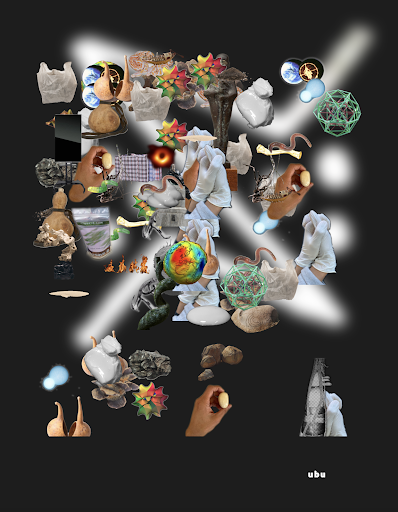 ‘An essay game is a modest experiment. It’s basically an attempt, an incomplete form that tries to rearrange existing knowledge.’ (Image courtesy of artist)
‘An essay game is a modest experiment. It’s basically an attempt, an incomplete form that tries to rearrange existing knowledge.’ (Image courtesy of artist)
How to play the game
Step 1: Click a playable term.
Step 2: read passage aloud (ntu body) — listen.
Step 3: read index aloud (firmament) — listen
x repeat.
Step 4: click firmament for guide.
Step 5: track progress via the ubu-body image carrier bag. to disentangle the carrier bag click the ubu button.
Step 6: click ntu to hold screen
(and save to local disk).
Step 7: click black to switch cosmograms.
Below is a conversation I had with the artist in relation to the project.
Your new digital artwork is in the form of an essay game. What exactly is an essay game?
An essay game is a modest experiment. An essay is basically an attempt, an incomplete form that tries to rearrange existing knowledge. An essay game plays at reordering the world, and how we can know it.
You begin with the Bambara variations;
> Is your house in order?
> Is their house in order?
> Is our house in order?
> Is my house in order?
In relation to the question of liberation, who is them, who is us and who is me?
I think that is the very question of liberation. And there is no stable answer. Who am I? Am I me? Am I them? Are we me? Are they us? (rearrange and repeat).
This idea of variations seems to be a recurring mode of thinking for you. What does variation offer you?
Octavia E Butler tells us, “Everything you touch you change; everything you change changes you.” I’m interested in (obsessed with) liberation theory, which is both a theory of transformation and theory in transformation. The necessary but insufficient condition for transformation is possibility, and possibility is what motivates me. Let’s call it political work in the realm of the impossible. Sometimes I think of variation as a formal device that automates openness.
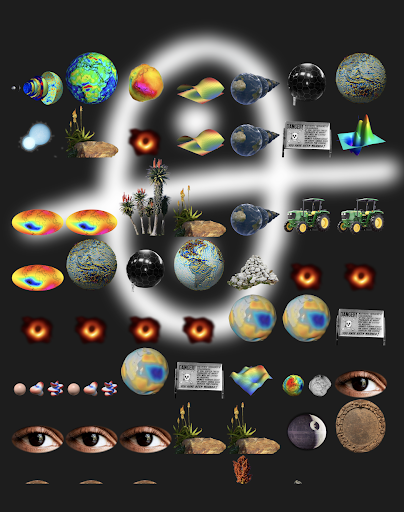 ‘Each diagram and iconogram in the game has a specific, if hidden, meaning. Some relations are fixed, but others are procedurally generated as you play.’ (Image courtesy of artist)
‘Each diagram and iconogram in the game has a specific, if hidden, meaning. Some relations are fixed, but others are procedurally generated as you play.’ (Image courtesy of artist)
Can you tell us about the music that accompanies the game?
The music in the game is a reworking of a classic 8-bit video game soundtrack. The thing about calling this work a game is that it’s about entering a temporary autonomous space. This music is both the soundscape of that world, as well as a path into this discrete world. I wanted it to feel okay to be there for a long time.
Can you tell us how the game is constructed?
The game mechanic is based on an imaginary architecture called Leakengine which I developed with Noa Mori (who wrote most of the code for a sun.black). The basic principles are:
a) reading is already an act of writing;
b) finding meaning and becoming meaningful is a collective act; and
c) moving at the speed of trust.
The game has three anatomical spaces: the landing, the grounding and the passage. Each space has a parabolic function related to these principles that unfold through time. The game asks for lots of time — maybe this is what feels so tender and laborious about it. It’s a lot, but I think it has to be.
I’m interested in the symbols that make up the language of the game. What is the usefulness of the symbols, if any?
Each diagram and iconogram in the game has a specific, if hidden, meaning. Some relations are fixed, but others are procedurally generated as you play. The point (or usefulness) of this arrangement is not in what it tells you — for example, this iconogram leads to Fanon; but rather, in how these image-text relations are formed, and later carried, in the game. If we replace usefulness with meaningfulness then the question is better answered by you.
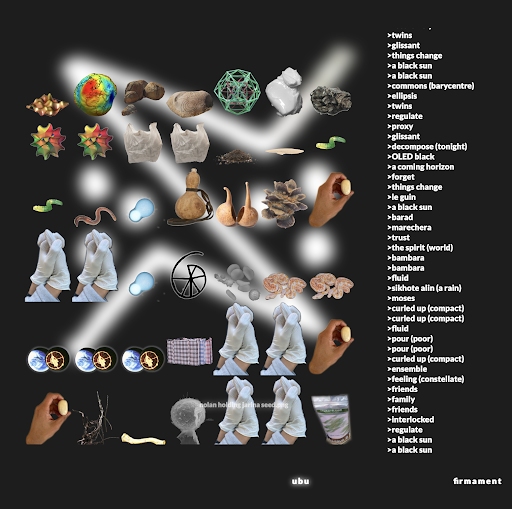 ‘The hope is that if you lend your time to the game, it will return it in the form of some collectively produced, meaningful aggregate.’ (Image courtesy of artist)
‘The hope is that if you lend your time to the game, it will return it in the form of some collectively produced, meaningful aggregate.’ (Image courtesy of artist)
It took me a while to get to this point but once I had played for long enough the game felt like a collection of beautiful and intricate poetry and lyricism. Can you tell us about the method in which each click reveals something?
The working title of the game was “longness”, and the primary material of this artwork is time. Specifically your time. So I’m happy that you shared it, thank you. The hope is that if you lend your time to the game, it will return it in the form of some collectively produced, meaningful aggregate.
The method of clicking hyperlinked text is a pretty standard HTML function: in our program, a click calls a new text fragment from an archive of Black liberation theory, which can, in turn, be clicked. a sun.black keeps all the options available, so everything is always present and clickable. The order of these fragments reflects your passage through the game.
Why was it important to allow the user-player to be able to save the ntu. Maybe the first question is to ask you to explain what ntu is and what ubu is?
I understand ubu-ntu through the work of the philosopher Mogobe B Ramose.
In his 1998 paper, “The philosophy of ubuntu and ubuntu as a philosophy”, Ramose says: “ubu- invokes the idea of be-ing in general. It is enfolded be-ing before it manifests itself in the concrete form or mode of existence of a particular entity. Ubu- as enfolded be-ing is always orientated towards unfoldment… In this sense ubu- is always oriented towards -ntu … Ubu- as the generalised understanding of be-ing may be said to be distinctly ontological. Whereas -ntu as the nodal point at which be-ing assumes concrete form, or a mode of being in the process of continual unfoldment may be said to be distinctly epistemological.”
In the game, this informs two spaces and functions within the digital architecture. I wouldn’t say it is important, but it is possible, to save the ntu as a concrete model of the process of unfoldment the game attempts to perform with you.
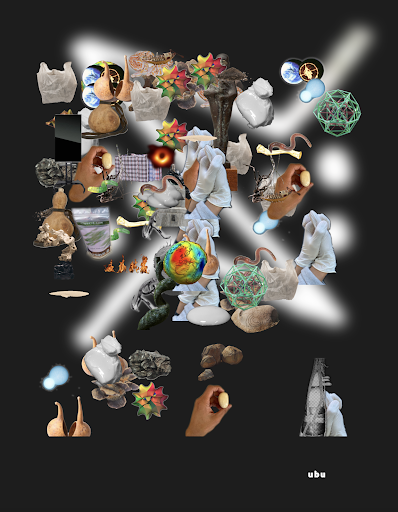 ‘I think virtual space has a minimum of possibility and I try to work to stretch that space of possibility for my own purposes (which are secret but shared with those who know another world is coming).’ (Image courtesy of artist)
‘I think virtual space has a minimum of possibility and I try to work to stretch that space of possibility for my own purposes (which are secret but shared with those who know another world is coming).’ (Image courtesy of artist)
I would argue that the digital has its own philosophical, ethical and social expressions. Insofar as your project is contemplating the digital, how are you thinking through these various expressions?
I think digital space extends our already virtual practices of commune-ication, for better or for worse. Digital space structures how we exchange and broadcast abstraction, which are affective, extractive, speculative et cetera. I mean things like friendship, debt, memory, identity, promises, community, dreams, plans. These are very real but also structure what is real. I think virtual space has a minimum of possibility and I try to work to stretch that space of possibility for my own purposes (which are secret but shared with those who know another world is coming).
As a visual artist who makes work for physical spaces, are you reflecting any differently about the online universe — in relation to your work and in relation to various readings of it?
Definitely, and more now that I’m stuck at home in front of my computer all day. The main thing about online space is its radical mutability. Our presence in it is assumed by not entirely necessary. I am thinking a lot about time and how we share it, and who this “we” is when so much computer time is time without “us”.
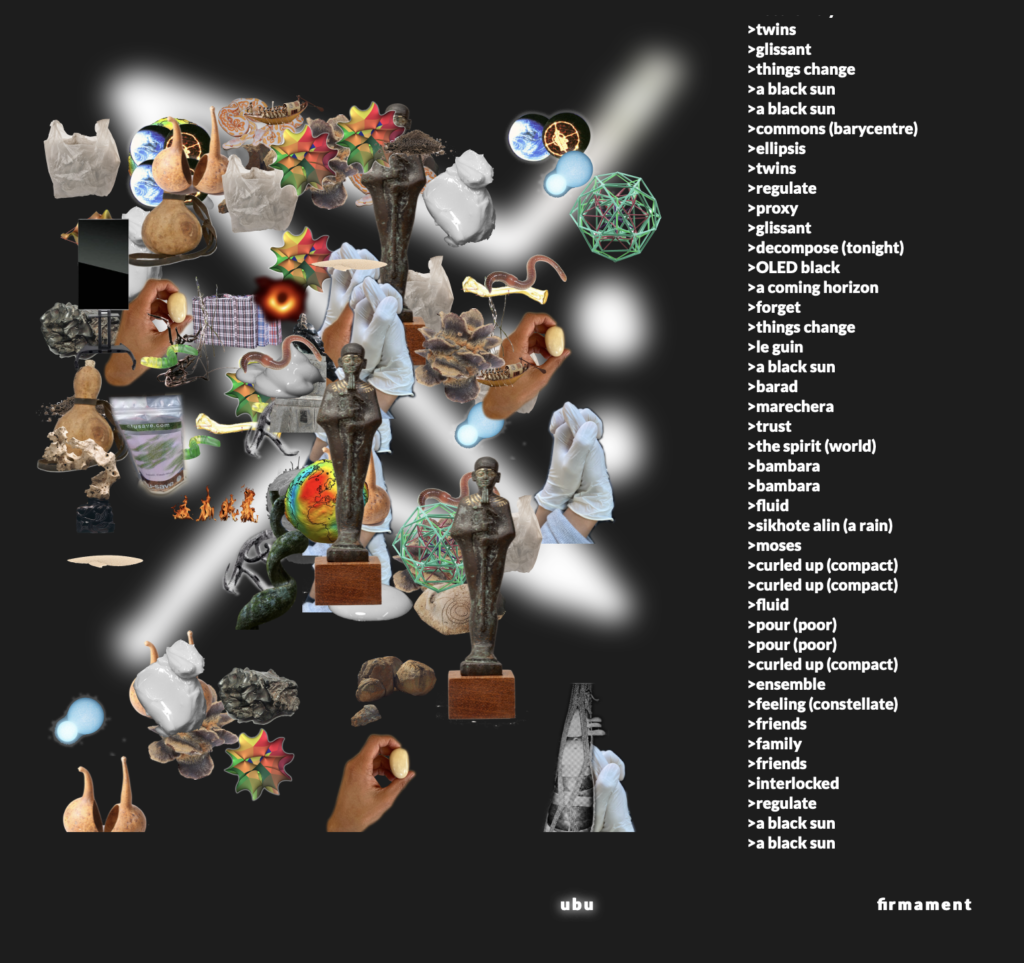 A modest experiment: A screenshots from the digital essay game, a sun.black, which is part of the larger are you for real project. (Image courtesy of artist)
A modest experiment: A screenshots from the digital essay game, a sun.black, which is part of the larger are you for real project. (Image courtesy of artist)
This question relates more to the bigger project, are you for real. I’m interested in the concept of ‘realness’ in its multiplicity … but less so in relation to the tension between the digital and IRL. More so in relation to how realness is determined. The stock market is as real as it is unreal; gender constructs are as real as they are unreal. Can you maybe tell us about how you’re thinking through this concept — in relation to the project or even more broadly?
Realness is about the distribution of power, the order of things. So what interests me is when the flow of the real is redirected and transformed to unreal ends: where the impossible exerts a modest pressure on the limits of what’s possible. I mean, what’s real is what you can do, or cannot do. Maybe that’s too abstract. a sun.black is an attempt to think with Toni Cade Bambara’s warning in her 1960 essay: “If your house ain’t in order, you ain’t in order. It is so much easier to be out there than right here. The revolution ain’t out there. Yet. But it is here.”
You can play a sun.black online at ru4real.de/en/#R2